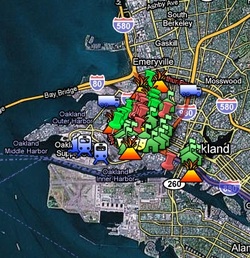Bay Area Freight Transport - Toxic Tours

The map shows major polluters and toxic sites throughout four regions of the San Francisco Bay Area: North Richmond, West Oakland, San Leandro, and Bayview Hunters Point in San Francisco. It provides an environmental justice based approach and is intended for use by community members, activists, and allies in the struggle to create healthy communities.
Air Pollution

Photo credit: The Pacific Institute (2006)
See or smell air pollution? File a complaint with the air district.If you have complaints about air quality including odors, smoke, and dust call 1-800-334-ODOR to document the air pollution.
Every complaint that is made is supposed to be investigated by a Bay Area Air Quality Management District field inspector. Names and addresses are confidential, and complaints can be filed anonymously.
Making a complaint:
- Call as soon as possible after detecting the air pollution.
- Try to identify the facility that is emitting the pollution.
- Be specific about smells, and try to compare them to common smells like rotten eggs, asphalt, or burning plastic.
- Explain the frequency of the problem. Is it a one time event or a reoccurring problem?
- Be sure to call each time or day that there is a problem.
- A report is written for each complaint. Request a copy of the report.
- Keep a written log of all the complaints that are filed.
Chemical Concerns
- Vinyl Chloride
- Bisphenol A (BPA)
- Toxic Chemicals and Infertility
- Toxic Chemicals Lobby: Exclusive Leaked Footage
